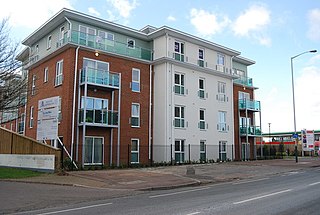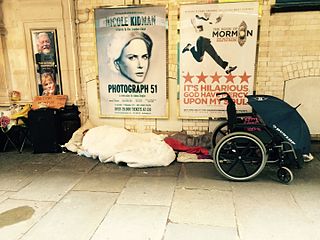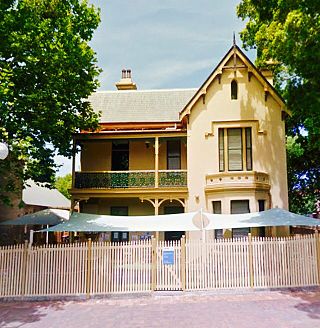Related Research Articles

In Ireland and the United Kingdom, housing associations are private, non-profit making organisations that provide low-cost "social housing" for people in need of a home. Any budget surplus is used to maintain existing housing and to help finance new homes and it cannot be used for personal benefit of directors or shareholders. Although independent, they are regulated by the state and commonly receive public funding. They are now the United Kingdom's major providers of new housing for rent, while many also run shared ownership schemes to help those who cannot afford to buy a home outright.

In the United States, the number of homeless people on a given night in January 2022 was 582,462 according to the Department of Housing and Urban Development. Annual federal HUD reports contradict private state and local reports where homelessness is shown to have increased each year since 2014 across several major American cities, with 40 percent increases noted in 2017 and in 2019.
Housing Benefit is a means-tested social security benefit in the United Kingdom that is intended to help meet housing costs for rented accommodation. It is the second biggest item in the Department for Work and Pensions' budget after the state pension, totalling £23.8 billion in 2013–14.

The Australian Council of Social Service (ACOSS) is an Australian organisation that advocates for action to reduce poverty and inequality, and is the peak body for the community services sector in Australia. It was formed in 1956.

Homelessness in Australia is a social issue concerning the number of people in Australia that are considered to be homeless. There are no internationally agreed upon definitions of homelessness, making it difficult to compare levels of homelessness across countries. A majority of people experiencing homelessness long-term in Australia are found in the large cities of Sydney, Melbourne, Brisbane and Perth. It is estimated that on any given night approximately 116,000 people will be homeless and many more are living in insecure housing, "one step away from being homeless". A person who does not obtain any shelter is often described as sleeping 'rough'.

In England, local authorities have duties to homeless people under Part VII of the Housing Act 1996 as amended by the Homelessness Act 2002. There are five hurdles which a homeless person must overcome in order to qualify as statutory homeless. If an applicant only meets the first three of these tests Councils still have a duty to provide interim accommodation. However an applicant must satisfy all five for a Council to have to give an applicant "reasonable preference" on the social housing register. Even if a person passes these five tests councils have the ability to use the private rented sector to end their duty to a homeless person.
Housing First is a policy that offers unconditional, permanent housing as quickly as possible to homeless people, and other supportive services afterward. It was first discussed in the 1990s, and in the following decades became government policy in certain locations within the Western world. There is a substantial base of evidence showing that Housing First is both an effective solution to homelessness and a form of cost savings, as it also reduces the use of public services like hospitals, jails, and emergency shelters. Cities like Helsinki and Vienna in Europe have seen dramatic reductions in homelessness due to the adaptation of Housing First policies, as have the North American cities Columbus, Ohio, Salt Lake City, Utah, and Medicine Hat, Alberta.

Homelessness in the United Kingdom is measured and responded to in differing ways in England, Scotland, Wales and Northern Ireland, but affects people living in every part of the UK's constituent countries.

Homelessness or houselessness – also known as a state of being unhoused or unsheltered – is the condition of lacking stable, safe, and functional housing. The general category includes disparate situations, including:

The San Francisco Bay Area comprises nine northern California counties and contains four of the ten most expensive counties in the United States. Strong economic growth has created hundreds of thousands of new jobs, but coupled with severe restrictions on building new housing units, it has resulted in an extreme housing shortage which has driven rents to extremely high levels. The Sacramento Bee notes that large cities like San Francisco and Los Angeles both attribute their recent increases in homeless people to the housing shortage, with the result that homelessness in California overall has increased by 15% from 2015 to 2017. In September 2019, the Council of Economic Advisers released a report in which they stated that deregulation of the housing markets would reduce homelessness in some of the most constrained markets by estimates of 54% in San Francisco, 40 percent in Los Angeles, and 38 percent in San Diego, because rents would fall by 55 percent, 41 percent, and 39 percent respectively. In San Francisco, a minimum wage worker would have to work approximately 4.7 full-time jobs to be able to spend less than 30% of their income on renting a two-bedroom apartment.

Caretakers Cottage is an Australian non-profit, non-governmental organisation based in Sydney assisting children and young adults facing homelessness. Caretakers Cottage is funded by the New South Wales Department of Communities and Justice to provide services for young people across Sydney's South-Eastern district. Services include short-term, emergency accommodation, semi-independent living options, case support and early intervention for young people at risk of homelessness.
Coast Shelter is a non-profit organisation supporting homeless young people, adults and women and children experiencing domestic & family violence in the Central Coast region of New South Wales, Australia. Coast Shelter is the largest regional Specialist Homelessness Service in NSW and provides a range of accommodation and other services to those experiencing hardship in the local community.
Detour House is a non-profit organisation servicing homeless and other at-risk girls and women, based in Sydney, Australia. Detour House also incorporates The Girls Refuge, a crisis accommodation service for homeless girls.
Homelessness NSW is the peak body organisation representing homelessness services in New South Wales, Australia. Homelessness NSW advocates on behalf of agencies and homeless people across NSW, with a particular focus on single men, single women, families and children.
Homeless Persons' Week (HPW) is an annual event publicizing the plight of homeless people in Australia. The event is held in the first full week of August each year, and is coordinated by Homelessness Australia, the peak body organisation for the Australian homelessness sector. Government and NGOs aim to change the public understanding of homelessness as being a problem beyond street sleepers. Primary homelessness, or people sleeping rough, is not the only form of homelessness in Australia and is not representative of the true state and scale of the homeless population. Of the 105,000 people in Australia who were estimated to be homeless at the last census, about 16,000 (15%) were sleeping rough on the streets. The others are those living in other unsuitable housing or in homeless shelters.
Homelessness SA is the peak body organisation representing homelessness services in South Australia. The group was formed in 2001 as a merger of three peak body groups which separately represented homeless men, women and youth. The groups were Youth Housing Network (YHN), Council to Homeless Persons SA (CHPSA), and the Women's Emergency Services Coalition (WESC). Homelessness SA advocates on behalf of agencies and homeless people across SA.

Family homelessness refers to a family unit who do not have access to long term accommodation due to various circumstances such as socioeconomic status, access to resources and relationship breakdowns. In some Western countries, such as the United States, family homelessness is a new form of poverty, and a fast growing group of the homelessness population. Some American researchers argue that family homelessness is the inevitable result of imbalanced “low-income housing ratio” where there are more low-income households than there are low-cost housing units. A study in 2018 projected a total of 56,342 family households were recognized as homeless. Roughly 16,390 of these people were living in a place not meant for human habitation. It is believed that homeless families make up about a third of the United States’ population, with generally women being the lead of the household.
Homelessness in Greece refers to the state or process of sleeping in housing that is below the minimum standard or lacking secure tenure, in relation to the nation of Greece. Austerity measures and the ongoing fiscal crisis have significantly spurred the rise in homelessness in Greece in the 21st century. Instances of homelessness have been dominantly concentrated in the city of Athens. Homelessness remains a relatively under-examined area of social policy in Greece, with the first organised counting for homeless people taking place in May 2018. Governments and non-profit organisations alike have made efforts to counter this phenomenon.
The Foyer housing model is a method of transitional housing for youth that evolved from temporary housing for laborers in Europe. After World War II, foyers were used to provide accommodation for a movement of people from rural France to cities seeking work. The term "foyer" means hearth in French. They later developed to house migrant workers, primarily from Algeria, serving as a path to independent labor and accommodation.
Community housing in Australia is not-for-profit affordable housing provided by community housing organisations known as Community Housing Providers (CHPs). It is part of the social housing sector. CHPs have varying modes of operation and structure, and different types of stock. Any budget surplus in CHPs must be used to maintain existing housing, to provide better services for tenants or to help finance new properties. Although independent, the CHPs are regulated by the state, and commonly receive public funding. Most of their stock is owned by public housing authorities (SHAs) in each State, and the CHPs manage the tenancies using the rent received from tenants.
References
- ↑ "What We Do". Homelessness Australia.
- ↑ "Joint statement from National Shelter, Community Housing Federation of Australia and Homelessness Australia - Shelter (National)". 23 December 2014.
- ↑ Browne, Rachel (24 May 2016). "'I ended up losing everything': How a shoulder injury set Ian's life off course". Sydney Morning Herald.
- ↑ Webb, Eileen (3 August 2016). "Ghost-hunting: will the census reveal the true scale of homelessness in Australia?".